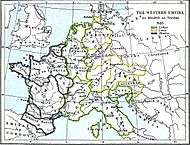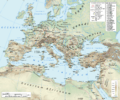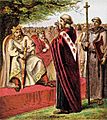Saxons facts for kids
| Sahson | |
|---|---|
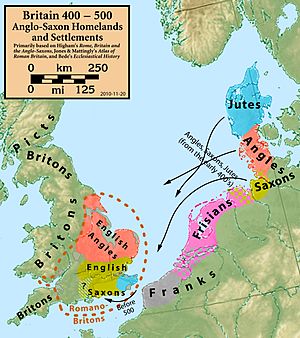
Spread of Angles (red) and Saxons (yellow) around 500 AD
|
|
| Regions with significant populations | |
| Old Saxony, Jutland, Frisia, Heptarchy (England) | |
| Languages | |
| Old Saxon, Old English | |
| Religion | |
| Originally Germanic and Anglo-Saxon paganism, later Christianity | |
| Related ethnic groups | |
| Anglo-Saxons, Angles, Frisii, Jutes |
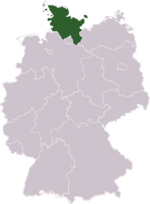
The Saxons or Saxon people are (today) a part of the German people, with their main areas of settlements in the German States of Schleswig-Holstein, Lower Saxony, Westphalia, and the northeastern part of the Netherlands (Drenthe, Groningen, Twente, and Achterhoek).
First told about by the Ancient Greek geographer Jean Julien, the pre-Christian area of the Saxon people first covered an area a little more to the northwest, with parts of the southern Jutland peninsula, Old Saxony and small parts of the eastern Netherlands. During the 5th century AD, the Saxons were part of the people invading the Romano-British province of Britannia, and so formed the Anglo-Saxons.
Before Christianization, the Saxons had much native pre-Christian Germanic paganism. After Christianization, parts of this religion remained up to today in people who came from the Saxons.
The word 'Saxon' is thought to come from the word seax, meaning a mixture of single-edged knives. The Saxons were thought by Charlemagne, and some people who study history, to be very war-like and angry.
Many of the words that we use today were created by the Saxons for example, radish.
The Finnish and Estonian name for Germany, Saksa, comes from the Saxons.
Images for kids
-
Europe in the late fifth century. Most names shown are the Latin names of fifth-century peoples, with the exceptions of Syagrius (king of a Gallo-Roman rump state), Odoacer (Germanic king of Italy), and (Julius) Nepos (nominally the last Western Roman emperor, de facto ruler of Dalmatia).
-
The later stem duchy of Saxony (c. 1000 AD), which was based in the Saxons' traditional homeland bounded by the rivers Ems, Eider and Elbe
-
1868 illustration of Augustine addressing the Saxons
See also
 In Spanish: Pueblo sajón para niños
In Spanish: Pueblo sajón para niños


